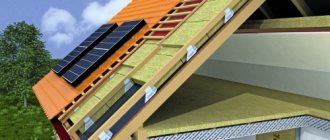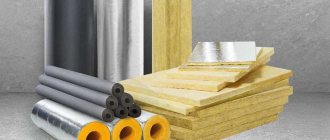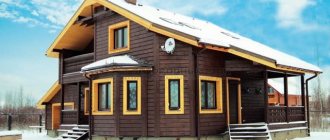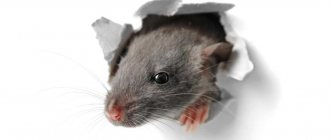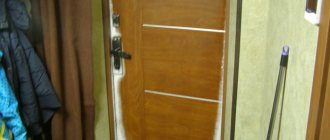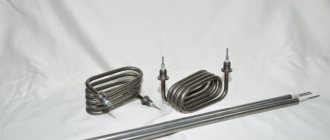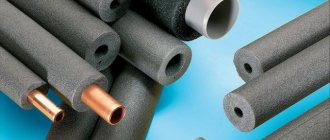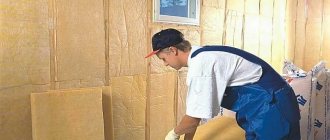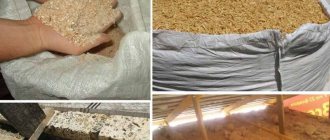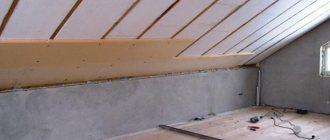The main quality of a good home is the ability to retain heat for a long time without loss, and therefore you should be especially careful when choosing insulation. The modern market of thermal insulation materials includes about 15 types of insulation. We have selected 9 of the most effective ones that are suitable for any structure
Read in the article:
- Mineral (stone) wool
- Extruded polystyrene foam
- Liquid foam
- Cork insulation
- Foam glass
- Ecowool
- Sawdust
- Straw
- Hemp and flax
1
Mineral (stone) wool
Rock wool is one of the most common and sought-after insulation materials on the market, and there are several reasons for this.
High heat saving ability
. The thermal conductivity of stone wool varies from 0.035 to 0.042 W/(m*K). In other words, a 10 cm thick layer of this material retains heat as well as 25 cm of timber or 117 cm of brickwork.
Fire safety.
Stone wool does not burn or smolder, because the melting point of basalt fibers exceeds 1000°C.
Vapor permeability.
Thanks to its relatively loose, “airy” structure, stone wool allows water vapor to pass through, which is formed in the house as a result of human activity (showering, cooking, washing, etc.). This means there is no need to worry about mold formation.
Sound absorption ability.
The same fibrous structure makes mineral wool a good sound insulator. So, when covering facades with stone wool, you can solve two problems at the same time: the house will become both warm and quiet.
Resistance to aggressive environments.
Mineral wool insulation is not afraid of mold, mildew and aggressive chemicals. And of course, “foamed stone” does not arouse food interest among insects and rodents.
Light weight.
A package of slabs with a total area of 0.35 m² weighs from 10 to 70 kg (depending on the thickness of the material). Thanks to its relatively low weight, both transportation and installation are facilitated.
Minor shrinkage.
Unlike many loose materials, stone wool almost does not lose volume over time. And that means heat-saving properties.
Durability
. The material retains its performance characteristics for 70-100 years.
Mineral wool in rolls
Mineral wool in slabs
A new method of thermal insulation - liquid insulation
Liquid insulation has relatively recently appeared on the building materials market. Its practicality and ease of use are the main selection criteria. Compared to other thermal insulation materials, it does not take up space.
The scope of application is very wide - facades, interior walls, pipelines, metal roofs and garages, basements. It is also actively used in the fight against condensation formation.
Pros:
- application to the base, incl. hard to reach places;
- minimum level of thermal conductivity (0.001 W/(m×K);
- a surface of up to 100 m² can be treated per day;
- resistance to mechanical stress;
- reduction in heat costs by 27%;
- does not change appearance;
- there is no preparatory stage;
- fireproof
The disadvantages of insulation are sensitivity during transportation and high price range. In addition, there are no formulas for accurately calculating the need, which can subsequently increase the budget.
Flaws
High price.
Basalt wool is quite expensive. One cubic meter of material costs from 1,500 to 6,500 rubles. (depending on density and a number of other factors). Such a high price tag is primarily due to the complexity of production and the need to use expensive equipment, in particular blast furnaces.
Use of environmentally unsafe materials.
Stone wool consists of more than 95% of stone itself, but it cannot be called an absolutely natural product. To prevent the boards from falling apart into fibers, manufacturers are forced to use binders, in particular formaldehyde resins. Of course, self-respecting companies use them in minimal quantities, but there is always the possibility of “running into” a low-quality product that emits toxic fumes.
There is only one way to minimize risks - by checking the documents for the products. The laws of the Russian Federation require manufacturers of heat-insulating materials to obtain a Fire Safety Certificate, as well as an Expert Opinion on compliance with current sanitary standards and rules.
Factors influencing thermal conductivity
Thermal conductivity depends on the density and thickness of the insulation, so it is important to take it into account when purchasing. Density is the mass of one cubic meter of materials, which according to this criterion are classified as very light, light, medium and hard. Lightweight porous products are used to cover interior walls and load-bearing partitions, while dense ones are used for exterior work.
Modifications with lower density are lighter in weight, but have better thermal conductivity parameters. A comparison of insulation materials by density is presented in the table.
| Material | Density indicator, kg/m3 |
| Minvata | 50-200 |
| Extruded polystyrene foam | 33-150 |
| Polyurethane foam | 30-80 |
| Polyurethane mastic | 1400 |
| Ruberoid | 600 |
| Polyethylene | 1500 |
The higher the density, the lower the level of vapor barrier.
The thickness of the material also affects the degree of heat transfer. If it is excessive, the natural ventilation of the premises is disrupted. Small thickness causes cold bridges and condensation on the surface. As a result, the wall will become covered with mold and mildew. You can compare the thickness parameters of materials in the table.
| Material | Thickness, mm |
| Penoplex | 20 |
| Minvata | 38 |
| Cellular concrete | 270 |
| Brickwork | 370 |
When selecting thickness, it is worth taking into account the climate of the area and the material of construction.
Types of stone wool
Basalt-based insulation is available in several modifications. Rolled fabric (the width of which is usually 1.2 m, and the length varies from 7 to 12 m), from most manufacturers has a low density - only 35 kg/m³. This material can only be used for horizontal laying in areas without any load. Such solutions do not occur very often.
The large area of the rolled fabric allows it to be laid with a minimum number of seams, and therefore cold bridges
The most popular is stone wool in the form of slabs (dimensions 0.6-1 m by 1.2 m and thickness from 30-200 mm). The main factor determining the scope of their application is density. Depending on this, the material is divided into several grades.
P-75
(density 75 kg/m³). Used for insulating surfaces with minimal load, for example, interior partitions and ceilings.
P-125
(125 kg/m³). Suitable for thermal insulation of floors, interfloor ceilings and facades.
PZh-175
(175 kg/m³). Designed for thermal insulation of reinforced concrete and metal walls and ceilings.
PPZh-200
(200 kg/m³). The material of maximum density is used for insulating roofs and floors under screed.
What is the best way to insulate facades – from the inside or the outside?
There are three options for positioning the insulation relative to the wall.
The first one is from the inside.
This method has few advantages. This is ease of installation (working indoors is more comfortable than outdoors) and there is no need to protect the insulation from harsh external influences. The disadvantages are much more significant. First of all, this is a loss of precious usable space. And the greater the thickness of the insulation, the less free space.
Another disadvantage is the risk of the walls getting wet. Stone wool is a vapor-permeable material. Water vapor passes through it unhindered, after which it begins to accumulate at the “cold wall-insulation” boundary or in the thickness of the wall. So, when choosing this installation method, you need to install a vapor barrier on the side of the room and organize effective (possibly forced) ventilation.
If you place the insulation outside
, the so-called dew point (water vapor condensation zone) will shift into the thickness of the mineral wool, from where the liquid will evaporate naturally. This means that the wall will no longer get wet.
In addition, external insulation protects the wall from alternate freezing and thawing, which has a beneficial effect on the “weather in the house.” And of course, if the mineral wool is located outside, there can be no talk of any loss of usable space.
The disadvantage is that the insulation has to be protected from atmospheric moisture and mechanical damage by covering it with plaster (wet facade) or cladding panels (hinged ventilated facade).
And finally, the third way. In this case, the insulation is laid on the outside of the wall and covered with facing bricks
. In this case, stone wool is reliably protected from external influences, there is no loss of usable area and other disadvantages described above. The only problem is that this solution is optimal only for buildings under construction. It is problematic to insulate an already finished house in this way, since increasing the thickness often requires strengthening (remodeling) the foundation.
Read more in the article “Pele’s Hair”
2
Why is thermal insulation needed?
The relevance of thermal insulation is as follows:
- Keeps you warm in winter and cool in summer.
Heat loss through the walls of a typical multi-storey residential building is 30-40% . To reduce heat loss, special thermal insulation materials are needed. The use of electric heaters in winter contributes to additional energy costs. It is more profitable to compensate for these costs by using high-quality thermal insulation material, which ensures heat retention in winter and coolness in the summer heat. At the same time, the cost of cooling the room with air conditioning will also be minimized.
- Increasing the durability of building structures.
In the case of industrial buildings using a metal frame, insulation helps protect the metal surface from corrosion, which is the most detrimental defect for this type of structure. And the service life of a brick building is determined by the number of freeze/thaw cycles. The impact of these cycles is perceived by the insulation, because the dew point is located in the thermal insulation material, and not in the wall material.
Such insulation allows you to increase the service life of the building many times.
- Noise insulation.
Protection against increasing noise levels is achieved by using such noise-absorbing materials (thick mattresses, sound-reflecting wall panels).
- Increasing the usable area of buildings.
The use of a thermal insulation system makes it possible to reduce the thickness of external walls, while increasing the internal area of the building.
Extruded polystyrene foam
Extruded polystyrene foam (EPP) is a progressive and modern material; it is quite closely related to the polystyrene foam familiar to each of us. Both insulation materials are made from polystyrene, but using fundamentally different technologies. And this causes significant differences in consumer properties.
Extruded polystyrene foam XPS
During the production of polystyrene foam, polystyrene granules are repeatedly treated with hot steam, which is why they increase in volume.
But at the same time, the micropores of the material increase. At first, the insulation copes with its duties perfectly. But over time, under the influence of moisture and other aggressive factors, it simply crumbles into individual grains. Although even polystyrene foam that has just “come off the assembly line” has rather low strength. It crumbles easily and has almost no resistance to bending.
In the case of extruded polystyrene foam, the granulated raw material is placed in a reactor where it is subjected to heat and pressure.
Then, when the polymer melts, the pressure is released, which leads to active foaming, and the resulting mass is passed through an extruder.
The result is a material consisting of closed cells with strong molecular bonds. This implies the main advantage of extruded polystyrene foam. It is approximately 5 times stronger than polystyrene foam.
Extruded polystyrene foam is an effective insulation material. A 10 cm thick EPP board retains heat as well as a 150 cm thick brick wall.
Lightweight, usable roof system for pedestrian loads with plastic supports.
High strength allows the EPP to withstand quite significant loads, and this, in turn, provides a wide range of applications. This insulation is used not only for walls and ceilings, but also for foundations, blind areas, and used roofs. It is used to fill well masonry during the construction of brick houses. It is included in the design of many sandwich panels.
It is also worth noting that polystyrene foam is an exceptionally lightweight material.
It puts virtually no load on the walls and foundation, and also does not create problems during installation
.
The slabs lend themselves perfectly to mechanical processing, and glue and dowels are enough to secure them to the walls.
An important advantage of polystyrene foam is its almost complete waterproofness.
. Even when dipped, it absorbs less than one percent of the liquid.
But unfortunately, EPP has quite noticeable disadvantages.
The first, and probably the main one, is
extremely low vapor permeability.
In simple words, this material does not “breathe” well. You should not insulate the walls from the inside with it - settling condensation will lead to the formation of mold. Experts recommend using this heat insulator outside and covering it with plaster. You can also lay polystyrene foam boards inside frame structures, but it is extremely important to create an air gap for proper ventilation.
Like regular polystyrene foam, extruded polystyrene foam is “afraid” of certain chemical reagents.
For example, bitumen mastics, which are used as waterproofing. Under their influence, EPP becomes soft and sometimes even dissolves.
To avoid blowing through the seams, EPP boards should be laid in two layers, with bandaging
More details in the article “Foam plastic”
3
Top 10 best insulation for home
HeatKnauf NORD
This type of thermal insulation materials is very simple not only in the installation process, but also does not require additional care during operation. It is produced by a world-famous company that has been specializing in the manufacture of high-quality products for building construction and interior decoration for many years. Insulation is used both by professional builders who pay special attention to quality at every stage of the work performed, but also by homeowners who seek to give preference to the best materials. With the help of such insulation it is possible to reduce heating costs by about 30-40% even in the harshest winter. The material is durable, withstands temperature and other physical stress well, and is well suited for working in conditions with extremely low temperatures. It is produced using a unique technology in one layer (mono layer), which allows you to maintain the integrity of the slab even under strong impacts. The Fine Fiber method of maximally elastic fiber is also used here.
The product contains about a third more fibers compared to other insulation materials. It retains heat well despite the small thickness of the mat and is characterized by increased hardness. The product is suitable for both external and internal work - it does not emit harmful substances at all. The material has increased hardness and elasticity. It retains its beneficial qualities for 50 years and is absolutely moisture resistant. This insulation can be used to cover any base - roofing, frame walls, internal partitions, ceilings.
More: Top 10 best gas and gas-wood stoves for saunas
Advantages:
- Convenient during installation;
- Reasonable cost;
- Long service life;
- Does not irritate the skin of the hands - you can work without gloves;
- Versatile in use.
Flaws:
- It can harbor mice.
HeatKnauf NORD
Rockwool Light Butts extra
It is made on the basis of natural rock – basalt. Absolutely environmentally friendly insulation, which is a multifunctional solution for working in individual housing construction. Well suited for load-bearing and self-supporting structures, as well as for non-load-bearing partitions. In particular, it can be used to insulate three-layer walls, the finishing of which is made using small-format materials. It is allowed to insulate surfaces both outside and inside the room, floors, ceilings. The product is characterized by increased strength, resistance to temperature influences, and a high thermal insulation effect. Installation does not involve complex work on preparing the base and installing insulation, so even a novice builder can do it.
The material feels good both in vertical and horizontal positions - the maximum height of slabs installed on top of each other can reach 6 meters, and they are allowed to insulate even inclined structures, for example, roofs. It does not shrink and remains rigid throughout its entire service life. It is characterized by increased vapor permeability - excess moisture will not accumulate in the rooms. Also, the insulation does not create additional load on the walls.
Advantages:
- Does not burn;
- Differs in insignificant mass;
- During operation it is not subject to deformation;
- Long service life;
- Universal to use;
- It has high vapor permeability and improved sound insulation characteristics.
Flaws:
- It's quite expensive.
Rockwool Light Butts extra
ISOVER Warm Home Stove
This material is based on very thin fibers, which are obtained by melting mineral raw materials at a very high temperature. The product is produced in the form of slabs that can be easily cut and sawed. The insulation does not conduct heat well through itself, but water vapor escapes through it almost instantly - you don’t have to worry about the formation of mold. It can also be used as thermal insulation. This characteristic is ensured due to the special structure of the material, because the air gap located between the fibers dampens not only sound, but also vibration vibrations. The product is non-flammable, so it is absolutely safe to use, which allows it to be used for finishing frame, wooden and cobblestone houses. The weight of the slabs is insignificant, the service life is at least 50 years. During the manufacturing process, insulation materials are treated with special water-repellent agents, which ensure high water-repellent qualities.
It is not advisable to use this product for interior decoration, since it is produced with the addition of phenol-formaldehyde resins, which are used as a binder for fibers. Over time, they begin to release harmful fumes into the environment, which can harm human health.
Advantages:
- In addition to high-quality thermal insulation, it has high sound insulation and water-repellent characteristics;
- Long service life - from 50 years or more;
- Low price;
- Insignificant mass of material.
Flaws:
- Not recommended for residential use.
ISOVER Warm Home Stove
PENOPLEX Comfort
It is used quite often in professional and individual construction. Has excellent technical parameters. Essentially, the material is extruded polystyrene foam. High quality is ensured largely due to the cellular structure of the product. The size of the cells ranges from 0.1 to 0.2 mm. They are located as evenly as possible in the structure, which has a positive effect on the strength of the material itself and allows it to provide not only thermal insulation, but also sound insulation characteristics. It is worth noting that the cells are not isolated, but connected to each other. Water vapor escapes through such passages without lingering in the room. The sheets have edges made in the shape of the letter “L”, which not only greatly facilitates the installation process, but also reduces heat loss. As a rule, islands of cold appear at the joints of slabs; this does not happen when working with such material.
This is one of the lightest materials in our review - its density is a maximum of 35 kg/cub.m. The insulation does not absorb moisture and retains its original shape even under significant physical stress - its compressive strength is 0.2 MPa. The thickness of the slabs ranges from 2 to 12 cm. They are allowed to be used for interior decoration, since they do not emit toxic substances. The slabs have performed well in roof insulation, and they also have an extended temperature range from -50 to +75 degrees. There is no fungus or mold in their structure. The strength of the insulation is much higher compared to foam plastic, and it does not crumble. Due to the grooves, endurance in relation to physical influences increases.
More: Top 10 best adhesives for shoes
Advantages:
- Inexpensive material;
- Has expanded functionality;
- Absolutely harmless to humans;
- Easily withstands any physical activity;
- Easy to install;
- You can work without using protective equipment.
Flaws:
- Some users say that it quickly infests ants.
PENOPLEX Comfort
TechnoNIKOL Rocklight
This type of insulation is a non-combustible slab made from thin threads of rocks; the thickness of the material can be 50 or 100 mm. It can be used for additional sound insulation of residential, industrial and office premises, that is, places where people spend quite a lot of time. The insulation is very easy to install, so it is often used not only on large construction projects, but also in the construction of residential buildings. The mineral wool board is made from rocks and has extremely low thermal conductivity - according to this indicator, it is almost on par with the most expensive materials available on the market today. This product does not allow combustion processes to spread; it can withstand temperatures up to 450 degrees. The insulation retains its shape and size throughout its entire service life.
With its help, up to 97% of sound waves are absorbed, while it does not absorb moisture, however, a special vapor barrier will need to be laid on top of the material. The product does not rot or decompose during use; neither insects nor rodents live in it. Mold and mildew will also not develop in these products.
Advantages:
- The service life of the insulation is about 50-60 years;
- Pathogenic microorganisms do not grow in it, insects and rodents do not live;
- A high level of vapor barrier can provide excellent ventilation for the wooden walls of a house.
Flaws:
- You must wear protective gloves when working, and wear a respirator when cutting.
TechnoNIKOL Rocklight
Ecoplanet Linen Insulation
It is made exclusively on the basis of natural materials, which give this product unique performance qualities. The products are produced in the form of flexible slabs, intended primarily for internal thermal insulation of roofs, attics, walls, floors, ceilings, attic floors, partitions, and so on. Thermal insulation material is excellent for private construction, but it is often used for civil and industrial buildings. Linen products allow you to create the most comfortable microclimate in a room, which is very important in frame buildings, where insulation is the main building material. The product is absolutely environmentally friendly, there are no foreign odors in the room, and no harmful substances are released. The wooden structure receives high-quality protection against fungus and mold.
Excellent thermal insulation performance is achieved largely due to the low thermal conductivity coefficient and increased heat capacity of the material. It is worth noting that the product also has bactericidal characteristics, so it additionally purifies the air in the room. Despite the fact that the insulation is made exclusively from natural materials, it is not at all susceptible to rotting and allows moisture to pass through it well, without absorbing it. The service life is very long - about 70 years, the final load on the supporting structures is small. Installation is simple, does not require special skills and takes minimal time.
Advantages:
- Well suited for interior decoration;
- Does not absorb moisture;
- Features a long service life;
- Has high sound insulation characteristics.
Flaws:
- Relatively expensive;
- Not found in every hardware store.
Ecoplanet Linen Insulation
Steico Flex
Also called Woodflex, it is an environmentally friendly insulating material made from natural wood fibers. It can be used to fill elements of roofs, floors and walls during frame construction, and is suitable for thermal insulation of technical rooms and utilities. The product is quite elastic, so it is comfortable to finish even quite complex shapes. The insulation is absolutely safe to use; there is no need to worry about the release of chemical compounds into the air in the room; it is also not capable of causing an allergic reaction. Such slabs are easy to install, since no large amount of debris is generated during operation. Thermal insulation characteristics are very high due to the fact that during the manufacture of slabs, wood retains all its basic natural qualities. Each fiber of the material has the ability to absorb and accumulate heat. Using this feature, a comfortable atmosphere will be created in the house, and daytime temperature fluctuations will be minimized, which is most important on hot summer days.
Moisture can accumulate in the material, but its beneficial qualities will remain at the same level. Even if one cubic meter of insulation contains about 10 liters of water, it will still be able to maintain its original shape without a hint of deformation. The unique structure also provides fairly high sound insulation characteristics.
Advantages:
- Easy to install on any surface;
- Can be used as a filler in frame construction;
- Long service life;
- Excellent sound insulation performance.
Flaws:
- Ability to absorb moisture.
Steico Flex
Isobox plate
This insulation was released onto the market back in 2007 - it is manufactured by a fairly well-known domestic company, founded in 1992 and specializing in the production of finishing and building materials. The latest scientific developments, as well as the most modern technologies, were used to create products. Largely due to this, the insulation fully complies not only with Russian, but also with international standards. The basis here is mineral wool, which is an absolutely environmentally friendly material. With its help, you can significantly reduce heat loss, retaining heat inside the room. This product easily interacts with various chemicals contained in masonry materials. It does not react with plaster and other solutions, gypsum, or dry mixes.
More: Top 10 best concrete mixers, how to choose a concrete mixer?!
Thermal conductivity is practically zero, but it is necessary to lay the insulation in such a way that it does not come into contact with water. Otherwise, it begins to lose its useful characteristics. However, mineral wool easily withstands mechanical and physical stress and can be installed even in rooms with an aggressive environment. Despite the fact that the material is afraid of water, it easily passes water vapor through itself.
Advantages:
- Environmentally friendly composition;
- Convenient to use;
- Minimum level of thermal conductivity;
- Low cost.
Flaws:
- When working with such insulation, it is necessary to wear protective gloves, otherwise skin irritation is guaranteed;
- Afraid of exposure to moisture.
Isobox plate
Shelter EcoStroy Premium
Heat and sound insulating material made on the basis of polyester fibers. No harmful elements or adhesives are added during the manufacturing process. The technology used is thermal bonding of fibers, that is, they are connected to each other under the influence of only high temperature. Insulation can be used not only for walls, but also for other purposes - for example, for working with communications and utility networks. Designed for professional and household use. During installation it does not emit dust and does not irritate the skin and mucous membranes - it is allowed not to use personal protective equipment. During the work, there are no scraps left that could not be used in the future, which allows you to seriously save on working with such material. The insulation itself has no odor at all and does not cause allergic reactions.
The main difference from other materials is their unlimited service life. It can be dismantled from one place and installed somewhere else. Practically does not absorb water and always remains dry. Helps extend the life of wood, since moisture will not affect it. Thanks to the original technology, thermal insulation is unsuitable for the growth of fungal microorganisms, mold and other bacteria, although it consists entirely of organic fibers. According to users, it is an excellent barrier that prevents rodents from entering the house.
Advantages:
- High-quality material that can be used for various purposes;
- Made on a natural basis, does not cause allergies;
- Insensitive to water, fungi, mold.
Flaws:
- Quite expensive;
- Does not withstand high temperatures.
Shelter EcoStroy Premium
Isomin
The main raw material for this product is basalt rock, which is first crushed and then melted into fibers. They are held together with a binder based on synthetic materials, then the insulation is formed into slabs or rolls. The organic content here is low - about 4-5%. As a result, a fibrous structure is formed, where the main part is air. It is with its help that it is possible to minimize heat loss and create an obstacle to the passage of sound waves. The material is resistant to acids, alkalis, and other active chemical compounds, and has excellent thermal resistance. The products are absolutely environmentally friendly, as evidenced by the relevant certificates; they are also distinguished by their hypoallergenic properties.
The insulation is able to withstand temperatures up to 1000 degrees, while maintaining its structure and performance characteristics, so it is often used to treat the passages of exhaust pipes through wooden floors and roofs. It is allowed to be used for thermal insulation of hot water pipelines and boiler rooms. A high degree of vapor permeability prevents condensation and wetting of the insulated base. The product has excellent resistance to mechanical stress. The average service life is about 50 years.
Advantages:
- Acceptable cost of material;
- Sufficiently high density and strength, despite the low weight;
- Excellent quality;
- Retains heat and sound waves well;
- Does not allow condensation to form;
- There is no smell;
- Made from environmentally friendly materials.
Flaws:
- Not very convenient packaging.
Isomin
Liquid foam
Externally liquid foam (penoizol)
looks like elastic white foam, more than 90% consisting of air bubbles, which, in fact, provides a heat-saving effect.
According to the companies using this material, 10 cm of such insulation is equal to 30 cm of ordinary board foam, 20 cm of mineral wool or 2.5 m of brickwork.
Such impressive characteristics are largely due to the fact that the material is applied under pressure. Increasing in volume, the foam penetrates into the smallest depressions, cavities and cracks, forming a continuous heat-insulating layer without cold bridges.
High adhesion allows the use of liquid polystyrene for internal insulation of vertical and inclined planes, for example, attic roofs
Foamed foam insulation can be used to insulate almost any enclosed space: layered brickwork, false wall cavity, attic floor, etc.
Penoizol is especially popular among companies reconstructing old houses. After all, in order to insulate a building, you do not need to remove the façade cladding or dismantle the ceilings.
Penoizol can also be used outside the home. For example, it is used to insulate the walls of wells. To do this, you just need to make permanent formwork, spaced 3-5 centimeters from the outer walls of the shaft, and foam the resulting space.
Although carbide foam contains organic resins, it effectively resists fire and is self-extinguishing. According to the current classification in the Russian Federation, this insulation belongs to the flammability group G1 (low-flammability)
So, we have looked at the advantages of liquid foam, and there are quite a few of them. But, studying construction forums, you might think that penoizol is perhaps the worst material for insulating private houses. Of course this is not true. Most of the negative reviews are due to the fact that unscrupulous companies, seeking to save money at any cost, use low-quality raw materials and work “carelessly.” And yet it should be noted that this technology does have drawbacks.
The first, and perhaps the main one, is the environmental unsafety of the material.
. Liquid foam contains formaldehyde, which emits toxic fumes. Yes, they weather over time, but finishing work cannot be carried out in the house for another two weeks after insulation. And that's the minimum. It is advisable to wait a month or a month and a half with the “inner stuff” so as not to risk your health. As for finishing facades and other outdoor activities, there are no strict restrictions. But we repeat – it’s better not to take risks.
In addition, the relatively high hygroscopicity of liquid foam should be taken into account. Some companies add moisture-repellent agents (hydrophobizers) to the raw materials, and this minimizes the problem. But it doesn't solve it completely. Therefore, it is impossible to use liquid foam to insulate foundations and other areas that have direct contact with the soil.
Due to its low density, penoizol is categorically not suitable for insulating floors under screed. And the last problematic factor is shrinkage. Foam applied under pressure “deflates” over time. As a rule, it is insignificant - only 1-4%. But the heat-saving properties of the material are somewhat reduced.
To ensure that foam settlement is not critical, it should be applied in compliance with certain rules. So, in one pass, the material is applied to a height of no more than 3 m. But it is better to limit it to a height of 1 m. And only when the foam has slightly set, work can be resumed.
Read more in the article “Light foam”
4
What affects the service life of insulation?
As with everything, it is believed that the service life of insulation depends on its cost and quality. Manufacturers of the inexpensive substance claim that it can last at least 50 years. In practice, this figure is not confirmed by anything, so in the footnotes they write that today there is no standard operating time for insulation materials.
In addition, what the material is made of is important. Experts confirm that artificial fibers cannot provide a guarantee for more than 35 years. During this time, they dry out and break down. But the most important thing is that they lose half of their heat-saving properties.
While natural fibers do not lose their original qualities and can last for a longer period. According to regulatory recommendations, after completion of construction, each house must undergo an energy audit. Such checks should be carried out every 25 years so that the current level of heat-saving properties can be assessed. But since we are unable to find out the exact numbers due to verification, we use data that comes to us from Europe.
Cork insulation
Cork insulation is made from granulate - a piece of bark from which a panel of acceptable sizes can be cut does not exist in nature. No synthetic glues are used; the binder is the lingin contained in the bark. However, environmental friendliness is not the main advantage of the material.
Cork oak bark is an amazing raw material. Structurally, it resembles a honeycomb: each cubic centimeter contains hundreds of thousands of tiny cells. They are filled with air, which makes up almost 90% of the total volume. This makes cork the most effective natural heat insulator. It has the same thermal conductivity coefficient of 0.037–0.04 W/m K (at t = 25°C) as mineral wool.
A 30mm thick cork panel retains heat as well as a 40cm thick brick wall or a 15cm thick timber wall
The building material of the cells is the aforementioned lignin, which not only glues the granules together, but also provides elasticity to the material, as well as suberin, a waxy substance impermeable to water. Yes, despite its wood origin, cork is completely impervious to moisture
. Wet insulation is as effective as dry insulation.
It is also worth noting that there is practically no protein in cork, which serves as a breeding ground for harmful microorganisms.
But it contains a lot of tannin - tannin. This is what explains the durability of the material. By insulating your house with cork panels, you can forget about the problem forever - their lifespan is calculated in centuries. And these are not nice words from manufacturers: there are buildings with a centuries-old history that still have cork finishes to this day.
Another undeniable advantage of cork is its lightness.
One cubic meter weighs on average from 100 to 120 kg, which means it will be quite easy to install. And the load on the foundation will be minimal. This is especially important for wooden and frame structures that rest on piles or a monolithic strip foundation.
Despite its woody nature, cork is almost not subject to fire. When in contact with a flame, it does not light up, but only slowly smolders
Depending on the thickness (which varies from 5 to 30 cm), the slabs can be used to insulate walls, floors and roofs. This is a universal insulation. But why hasn’t this material displaced all other insulation materials from the market? The main limiting factor is price. Unfortunately, cork is a rather expensive material. The price for 1 m² 5 cm thick is 2277 rubles. (as of February 2022) But for effective thermal protection you need a layer at least 10 cm thick. Obviously, the cork “costs a pretty penny.” But, nevertheless, she is in demand.
Insulation of walls with cork
Cork in roof insulation
Cork in a green roof design
Read more in the article “Tested!”
5
Comparison of insulation materials. Thermal conductivity table
Comparison of foam block, mineral wool and polystyrene foam by thermal conductivity
The table above comparing thermal insulation by thermal conductivity gives a complete picture of which material is best to use. All that remains is to compare the data from the thermal conductivity table with the cost of thermal insulation from suppliers. In this case, it is necessary to accurately calculate the required thickness of insulation when using various materials in order to select the required amount of material.
Mode of production
The material is obtained as follows. At the first stage, a mixture (charge) is prepared from finely ground silicate glass and a carbon-containing gas former, which can be coal coke, anthracite, limestone or marble. Then the mixture is sent to a tunnel furnace, where at a temperature of about 900–1000°C the glass particles are softened to a viscous-liquid state, and gaseous CO2 and CO released as a result of carbon oxidation foam the glass mass, forming closed pores in it. The final product can be presented in the form of granules and crushed stone of different fractions, slabs, blocks. Let's talk about the most popular forms of foam glass in private housing construction.
Thanks to its exceptional properties, foam glass (otherwise known as cellular glass) can provide excellent heat and sound insulation of various building structures: roofs, walls, ceilings, etc.
Granular foam glass
Foam glass in the form of granules is the optimal heat insulator for floors on the first floor of a building. Unlike, for example, expanded clay concrete, the material is not hygroscopic, which means there are no conditions for wood to rot. The vapor permeability of expanded clay is 0.21 mg/(m•h•Pa), and foam glass is 0.001–0.005 mg/(m•h•Pa), moreover, it has half the density, so when producing heat-insulating backfill, You can get by with a layer half as thin. But as for the price, there is a clear advantage of expanded clay, which costs significantly less than granulated foam glass: 1450–2750 rubles. versus 6,000-12,000 rubles. per cubic meter.
The concept of thermal conductivity
Insulation materials have different coefficients of thermal conductivity - this is the main indicator of the material.
Thermal conductivity refers to the transfer of heat energy from object to object until the moment of thermal equilibrium, i.e. temperature equalization. In relation to a private house, the speed of the process is important - the longer the leveling takes place, the less the structure cools down.
In numerical form, the phenomenon is expressed through the thermal conductivity coefficient. The indicator clearly expresses the passage of the amount of heat in a certain time through a unit of surface. The larger the value, the faster the thermal energy flows away.
The heat transfer properties of various materials are indicated in the manufacturer's specifications on the packaging.
Foam glass slabs
A wide range of foam glass slabs and blocks designed for insulating various structural elements.
Foam glass slabs are a universal insulation material. In addition to excellent thermal insulation properties, they have high vapor and water resistance and exceptional strength. Foam glass has established itself as a material suitable for the construction of energy-efficient buildings using Passivhaus technology. In practice, it has been proven that if you lay 50 mm thick slabs with a thermal conductivity of 0.052 W/m•°C and a compressive strength of 16 kg/cm² between the base of the house and a brick wall, then with a temperature difference between the street and the room of 35°C (– 15 and +20°C, respectively) no condensation forms in the lower part of the wall, and its temperature is 16.3°C.
In comparison with other insulation materials, the service life of foam glass is practically unlimited, and over time it will not deteriorate its performance, and the slabs will not change their geometric dimensions, thereby eliminating heat loss through breaks in the insulating circuit. Foam glass provides noise absorption up to 56 dB, is environmentally and hygienically safe (does not emit toxic substances), and is immune to chemical influences.
The strength and load-bearing capacity of foam glass is such that a number of blocks laid under brick walls of seven floors can withstand this load without causing settlement and preventing the formation of cold bridges
One of the serious advantages of foam glass insulation is that it does not support combustion (which cannot be said about materials based on polystyrene foam) and does not deform at temperatures up to 450°C. And finally, “glass” will obviously not be to the taste of rodents and will not be harmed by microorganisms.
Slabs are produced with dimensions of 600 × 450 mm and thicknesses from 50 to 80 mm (in increments of 10 mm). For thermal insulation of building envelopes, products with a density of 150–250 kg/m³ are used. The material is easy to install: despite its rigidity, it can be easily machined (cutting, drilling) and glues well. To fasten the slabs and seal the seams between them, you should use compounds selected and recommended by the foam glass manufacturer, taking into account the characteristics of the base.
The slabs are glued outside the house directly to the insulated surface. If it is necessary to use two layers of insulation, the first of them is additionally fixed with dowels, and the second is laid with offset joints, also placing it on glue. Due to the excellent adhesive properties of foam glass, plastering work can be carried out without the use of reinforcing meshes and primers.
Read more in the article “Glass Formula”
6
Comparative analysis of thermal insulation materials
- Basalt insulation
- Glass wool
- Ecowool
- Extruded polystyrene foam
- Styrofoam
- Spray polyurethane foam
- Polyisocyanurate boards
- Penoizol
- Results
The Chemtrust team of technologists compared the most common thermal insulation materials with polyurethane foam according to several parameters: cost, thermal conductivity, flammability, vapor permeability, service life.
Which material is right for you depends on the type of structure, installation method, and budget.
Open comparison table (PDF)
Ecowool
As the name suggests, the majority of this insulation (about 81%) is recycled paper. The remaining 19% comes from antiseptics against pests and fire retardants that protect against fire. The material is extremely simple to manufacture, so it is inexpensive.
A layer of sprayed ecowool 150 mm in energy saving corresponds to a brick wall 4.5 bricks thick.
But what is more important is that paper insulation (aka ecowool) copes with its responsibilities perfectly. Just 15 cm of paper mixture corresponds in terms of heat conservation to a brick wall 4.5 bricks thick! In this case, the layer turns out to be homogeneous, without seams and voids. It is also important that it “breathes” perfectly, and therefore does not need a vapor barrier.
Another advantage of ecowool is that it can also serve as a sound insulator. A 100 mm thick layer reduces the noise level by approximately 60 dB.
Fire safety.
For material that is shredded paper, this issue is of great importance. As practice shows, cellulose insulation does not ignite upon contact with fire, but only smolders and quickly fades, having lost a heat source. But still, it’s worth dwelling on fire retardants in more detail.
Some manufacturers use ammonium sulfates and phosphates, which emit a pungent and unpleasant odor. But this is not the main problem. The trouble is that over time these additives lose their fire-retardant properties. Therefore, it is better to purchase material impregnated with borax (borax). This fire retardant does not have the disadvantages described above.
Borax protects not only from fire, but also from pests. Rodents cannot tolerate this substance, so they will not settle in the insulation layer.
Water resistance.
It would seem that the paper is not “friendly” with her. First of all, we note that it is impossible to allow any insulation to get wet - this has a very bad effect on its properties. But if an accident does occur, the cellulose fibers will retain some of the moisture that gets on it in the upper layers, from where it will quickly evaporate, so that the material will not be critically damaged.
Cellulose insulation is used to protect walls, attics, attics, roofs and floors on joists. But you can’t lay it under a screed - under the weight that has fallen, the loose material will become dense, which will reduce its useful properties to zero
The consistency of ecowool resembles fluff.
Ecowool is supplied in a compacted state (briquettes), which means that it must first be loosened. If manual installation is intended, this can be done with any convenient tools in a large container. Then the paper pulp is poured into the cavities of frame walls and ceilings. It is very important to observe the application density: for horizontal structures it is 35–40 kg/m³, for vertical structures it is 60–70 kg/m³. Obviously, this work requires a lot of time and effort. It is much faster and easier to apply the material using a special blow molding machine. It loosens the insulation itself and delivers it under pressure over a distance of up to 200 m horizontally and 40 m vertically. At the same time, ecowool penetrates into the smallest cavities and forms a uniform heat and sound insulating layer. The application density can be adjusted.
Other criteria for selecting insulation materials
Thermal insulation coating reduces heat loss by 30-40%, increases the strength of load-bearing structures made of brick and metal, reduces noise levels and does not take up the usable area of the building. When choosing insulation, in addition to thermal conductivity, other criteria must be taken into account.
Volume weight
The weight and density of mineral wool affects the quality of insulation
This characteristic is related to thermal conductivity and depends on the type of material:
The lower the volumetric weight, the less material is consumed.
Ability to keep fit
Plates and polyurethane foam have the same degree of rigidity and hold their shape well
Manufacturers do not indicate dimensional stability on the packaging, but you can focus on Poisson’s and friction ratios, resistance to bending and compression. The stability of the shape is used to judge the creasing or change in parameters of the heat-insulating layer. In case of deformation, there is a risk of heat leakage by 40% through cracks and cold bridges.
The dimensional stability of building materials depends on the type of insulation:
The ability of a product to keep its shape is also determined by its elasticity characteristics.
Vapor permeability
Determines the “breathing” properties of the material - the ability to transmit air and steam. This indicator is important for controlling the indoor microclimate - more mold and mildew forms in mothballed rooms. In conditions of constant humidity, the structure may collapse.
Based on the degree of vapor permeability, there are two types of insulation:
When installing vapor-permeable wool, a film vapor barrier is additionally laid.
Flammability
The indicator that is used to guide the construction of above-ground parts of residential buildings. The classification of toxicity and flammability is specified in Art. 13 Federal Law No. 123. The technical regulations highlight the following groups:
The best option for private construction is self-extinguishing materials.
Soundproofing
Characteristics related to vapor permeability and density. Cotton wool prevents the penetration of extraneous noise into the room; more noise penetrates through the foam.
Dense materials have better sound insulation properties, but installation is complicated by thickness and weight. The best option for independent thermal insulation work would be stone wool with high sound absorption. Similar indicators are found in light glass wool or basalt insulation with twisted long thin fibers.
The normal sound insulation indicator is a density of 50 kg/m3.
Flaws
So, it would seem that there are no obvious problems. So why is this insulation not popular among us? There are several reasons.
Let's start with the fact that in Russia there are no standards for the composition of paper insulation, so the manufacturer can regulate the quality of the product itself. It is unnecessary to say what this sometimes leads to.
During installation, there are also moments of risk. Workers interested in saving material may apply it in a looser layer than necessary. This means strict control is needed.
Although ecowool does not burn, it smolders, which means that when insulating attics and attics, you will have to insulate chimney pipes with non-combustible materials.
And finally, the most noticeable drawback is the price. The material itself is cheap, but workers’ services and equipment depreciation will also have to be paid for. The average cost of 1 m³ on a turnkey basis varies from 1,700 to 5,200 rubles.
Read more in the article “Boo...smears”
7
The main mistakes when choosing insulation for walls
Let's look at the main mistakes when choosing thermal insulation materials. This will save you from unnecessary expenses and rework.
- Saving. A low-quality thermal insulator will not only quickly become unusable, but will also compromise the integrity of the wall. Poor insulation can cause mold, mildew, or even the collapse of part of the façade. Therefore, when choosing insulation, you should not take the cheapest product in the store.
- Fire safety. The insulation must not only be non-flammable or low-flammable, but also environmentally friendly. When choosing between synthetic and natural insulation, give preference to the latter.
Sawdust
Sawdust insulation can confidently be called a time-tested technology. In the USSR it was actively used, which is reflected in SNIP II-A.7-62 “Construction heating engineering. Design Standards" 1962. Moreover, sawdust-fill houses erected in the 19th century still stand and are in use today.
To be fair, it is worth noting that most old buildings have rather thin walls - about 10-12 cm, and in cold weather they have to be heavily heated. In modern houses, the layer of sawdust insulation is much thicker - 30-35 cm, and they fully comply with heat transfer resistance standards. But what makes progressive developers abandon polyurethane foam and stone wool in favor of wood waste?
Advantages of sawdust
An important advantage of sawdust is its low cost.
A bag with a capacity of 50 liters costs on average 100-300 rubles, a compressed briquette weighing 20 kg will cost 200-230 rubles. And with some luck, you can get wood waste for free. Many industries are ready to give them away for free in order to save themselves the hassle of garbage disposal.
According to the thermal insulation characteristics of sawdust, covered with a layer of 10 cm, corresponds to 8-9 cm of mineral wool or 7 cm of polystyrene foam
However, the affordable price is not the only advantage of sawdust. This material has amazing durability.
Synthetic insulation materials, such as polystyrene foam, polystyrene foam and polyurethane foam, last on average about 30 years (PIR boards retain their stated characteristics for up to 50 years). Mineral wool “lives” a little longer - 50-70 years. Shredded wood can retain its performance properties for 100 years or even more.
It is also worth noting such a useful quality for insulation as vapor permeability.
Sawdust “breathes” perfectly, which has a beneficial effect on the microclimate of the house. In addition, the developer has the opportunity to save on vapor barrier membranes, which are simply not needed for this type of thermal insulation.
But that is not all. A house insulated with sawdust is never too damp or dry.
The fact is that crushed wood is able to absorb condensation if the air becomes too humid, and evaporate it in the opposite situation. Polymer materials cannot boast of this.
And finally, let us mention the environmental friendliness of sawdust. They do not emit unpleasant “chemical” odors and do not pose a threat to the health of the inhabitants of the house.
STRIP FOUNDATION without insulation and with foam glass crushed stone
Classic strip foundation, buried below the freezing level
Strip foundation using foam glass crushed stone
| № | Name of works | UNITS change | Without foam glass | With fractionated foam glass | ||||
| quantity | price | sum | quantity | price | sum | |||
| 1 | Excavation work, soil sampling | m3 | 195 | 500 | 97 500 | 68 | 500 | 34 000 |
| 2 | Excavation work (backfilling of soil with compaction) | m3 | 98 | 300 | 29 400 | 17 | 300 | 5 100 |
| 3 | Sandy base with work | m3 | 26 | 800 | 20 800 | 14 | 800 | 11 200 |
| 4 | Fractionated foam glass: work | m3 | 15 | 350 | 5 250 | |||
| 5 | Fractionated foam glass: material | m3 | 15 | 3 000 | 45 000 | |||
| 6 | FBS blocks: work | PC | 90 | 350 | 31 500 | 60 | 350 | 21 000 |
| 7 | FBS blocks 3.28×0.6×0.58: material | PC | 90 | 3 200 | 288 000 | 60 | 3 200 | 192 000 |
| 8 | Foundation waterproofing | m2 | 150 | 470 | 70 500 | 100 | 470 | 47 000 |
| 9 | Geotextiles, with work | m2 | 65 | 60 | 3 900 | |||
| 10 | Asphalt concrete pavement, with work | m2 | 55 | 500 | 27 500 | |||
| TOTAL, rub.: | 537 700 | 391 950 | ||||||
| SAVINGS, rub. | 145 750 | |||||||
| Saving. % | 27,10 % | |||||||
Disadvantages of sawdust
Of course, speaking about the advantages of sawdust, we cannot help but talk about the disadvantages. The first and main one is fire hazard.
. Despite the fact that compacted insulation does not readily ignite and smolders rather than blazes with a bright flame, it is much more afraid of fire than other materials.
In a house insulated with sawdust, it is important to strictly follow fire safety rules and keep a fire extinguisher on hand. A fire alarm would also be a good idea.
When giving preference to wood insulation, you should take into account that mice can live inside frame walls.
However, this applies to all fill-in insulation. A fine-mesh metal mesh will provide reliable protection against rodents.
Another problem is susceptibility to rotting,
which can occur due to leaks, ineffective ventilation, etc.
And finally, the complexity of the installation process.
Sawdust cannot simply be poured out of a bag and left to its own devices. They will settle, decreasing in volume by one and a half to two times, and voids will form at the top of the walls, which will become bridges of cold. Tamping required. It is made using a small wooden block or cutting a board every 20 cm of material.
In addition, pouring with lime milk is advisable. It makes tamping more efficient and also serves as an antiseptic for the wood, preventing possible rotting.
Read more in the article “And there is sawdust in my wall...”
8
Straw
The design of the wall of a domed house insulated with straw blocks
It is difficult to believe that in the twenty-first century builders still use straw, but nevertheless it is so. Threshed, crushed and well-dried stems, pressed into blocks, can serve as both thermal insulation and wall material. “Bricks” are laid between the frame posts and plastered both outside and inside.
Straw blocks have many advantages. These are high thermal insulation characteristics, the ability to absorb irritating noise, low weight, and, importantly, low price. The average cost of one block 36 × 46 × 75 cm is 150-300 rubles.
Unfortunately, there are also many disadvantages - flammability, “phobia of water”, susceptibility to biological damage and low load-bearing capacity. Turning to straw when constructing a year-round residential building is quite risky. But in small summer buildings it can be used without fear.
Important!
The frame can only be filled with straw blocks after the roof has been erected. This is necessary to protect the material from getting wet.
Rye straw is considered the best raw material for the block (rodents do not like it), but wheat straw is also used. The optimal size of the “brick” is 40 x 50 x 50 cm
9
Practical application of thermal conductivity coefficient
The thermal conductivity coefficient is necessary to calculate the volume of insulation in a climate zone.
After a theoretical comparison of materials, it is necessary to take into account their division into thermal insulation and structural groups. Structural raw materials have the highest heat transfer indices, so they are suitable for the construction of ceilings, fences or walls.
Without using raw materials with insulation properties, you will need to lay a thick layer of thermal insulation. Referring to the thermal conductivity table, you can determine that low heat transfer of reinforced concrete structures will only occur if their thickness is 6 m. The finished house will be bulky, may sink under the soil, and construction costs will not pay off even after 50 years.
Sufficient thickness of the thermal insulation layer is 50 cm.
The use of thermal insulation materials reduces construction costs and reduces overpayments for energy in winter. When purchasing insulation, you need to take into account thermal conductivity parameters, main characteristics, cost and ease of self-installation.
